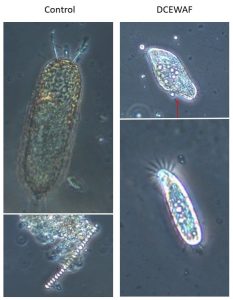Study Finds Dispersed Oil, But Not Oil Alone, Negatively Affects Phytoplankton
– JUNE 25, 2019
Scientists conducted mesocosm experiments to examine how oil and chemically-dispersed oil affect Gulf of Mexico phytoplankton. Exposure to oil alone did not impair phytoplankton growth or their photosynthesis ability, nor did it significantly change the community’s diversity. However, exposure to oil plus dispersant stopped phytoplankton growth and significantly decreased their photosynthetic efficiency. Phytoplankton exposed to chemically-dispersed oil exhibited reduced electron transport capacity and efficiency and a shift in community composition from diatoms to Euglenozoa (a group of microbes that eat other microbes). Increased formation of sinking marine particle aggregates was present in oil plus dispersant treatments only. The changes observed with phytoplankton when exposed to chemically-dispersed oil have potential implications for carbon and oil distribution and carbon turnover in the ocean’s water column.
The researchers published their findings in Aquatic Toxicology: Response of natural phytoplankton communities exposed to crude oil and chemical dispersants during a mesocosm experiment.
Marine phytoplankton produce extracellular polymeric substances (EPS) and transparent exopolymer particles (TEP), which are important steps in the ocean’s biological carbon pump. These processes depend on the phytoplankton’s health and their photosynthetic rate. Several studies after Deepwater Horizon identified phytoplankton anomalies in oil-spill affected areas (Geophysical Research Letters Hu et al., 2011 and Environmental Pollution Parsons et al., 2015), suggesting that changes may be associated with the oil and/or chemical dispersants used during response.
“Phytoplankton in the open ocean and deep coastal waters are the only photosynthesizers and, therefore, make up the base of most marine food webs,” explained study author Laura Bretherton. “Changes in phytoplankton community composition or their ability to grow and photosynthesize could have effects higher up the food chain. It’s really important that we understand how they are affected by pollutants like oil spills.”
To better understand the underlying mechanisms for observed phytoplankton changes in response to oil spill exposure, the team conducted 72-hour mesocosm experiments. They exposed natural Gulf phytoplankton communities to seawater (control), seawater with Macondo surrogate oil (an oil and water accommodated fraction or WAF), seawater with oil plus Corexit (chemically enhanced WAF or CEWAF) at a 20:1 ratio, and a CEWAF diluted ten times (DCEWAF).
The team monitored how the oil degraded through time. In the oil-only tanks (WAF), the mean starting concentration was around 0.3 mg/L and became close to detection limits at the experiment’s end. The full-strength dispersed-oil treatment (CEWAF) started at around 80 mg/L and the diluted version of that (DCEWAF) was around 8 mg/L. Over time these fell to just under 20 and 2 mg/L, respectively. “The CEWAF is certainly quite far outside environmental range (and is used here more as a reference for “extreme” toxicity), but both the WAF and DCEWAF vary within concentrations that were found at many sites throughout the Gulf following the spill,” explained Bretherton.
The team used genetic techniques (18S rRNA sequencing) to look at the community composition of our microbes. “We combined the community data with measurements of phytoplankton physiology and particle counts to get a unique insight into how phytoplankton contribute to particle formation following exposure to oil,” said Bretherton.
Photosynthesic activity increased in control and WAF treatments but was inhibited (suggesting slowed or inefficient photosynthesis) or neared/reached detection limits (suggesting lethality) in dispersed-oil treatments. Diatoms dominated eukaryote communities in control and WAF treatments but were replaced by heterotrophic Euglenozoa in dispersed-oil treatments. Total EPS concentrations were four-times higher in CEWAF treatments than all other treatments. TEP concentrations in DCEWAF treatments were two-times higher than controls and 1.5-times higher than WAF treatments. Dispersed-oil treatments had an increase in larger particle sizes (10 – 50 μm) and a decrease in total particle concentrations, suggesting increased aggregation of smaller particles.
“We observed that when phytoplankton are healthy and growing, there isn’t much particle formation happening,” said Bretherton. “Particle formation in the marine environment is important, because oil trapped in the particles can end up on the seafloor. So, the way phytoplankton respond to oil and dispersant exposure is important to understanding what happens to oil after a spill.”
Data are publicly available through the Gulf of Mexico Research Initiative Information and Data Cooperative (GRIIDC) at doi:10.7266/N7NP22G2, doi:10.7266/N7028PMG, doi:10.7266/N7RV0M1R, doi:10.7266/N7CF9NK6, and doi:10.7266/N7JD4V8Z.
The study’s authors are Laura Bretherton, Manoj Kamalanathan, Jennifer Genzer, Jessica Hillhouse, Samantha Setta, Yue Liang, Chris M. Brown, Chen Xu, Julia Sweet, Uta Passow, Zoe V. Finkel, Andrew J. Irwin, Peter H. Santschi, and Antonietta Quigg.
By Nilde Maggie Dannreuther and Stephanie Ellis. Contact maggied@ngi.msstate.edu with questions or comments.
************
This research was made possible in part by a grant from the Gulf of Mexico Research Initiative (GoMRI) to the Aggregation and Degradation of Dispersants and Oil by Microbial Exopolymers (ADDOMEx) consortium.
The Gulf of Mexico Research Initiative (GoMRI) is a 10-year independent research program established to study the effect, and the potential associated impact, of hydrocarbon releases on the environment and public health, as well as to develop improved spill mitigation, oil detection, characterization and remediation technologies. An independent and academic 20-member Research Board makes the funding and research direction decisions to ensure the intellectual quality, effectiveness and academic independence of the GoMRI research. All research data, findings and publications will be made publicly available. The program was established through a $500 million financial commitment from BP. For more information, visit https://gulfresearchinitiative.org/.
© Copyright 2010-2019 Gulf of Mexico Research Initiative (GoMRI) – All Rights Reserved. Redistribution is encouraged with acknowledgement to the Gulf of Mexico Research Initiative (GoMRI). Please credit images and/or videos as done in each article. Questions? Contact web-content editor Nilde “Maggie” Dannreuther, Northern Gulf Institute, Mississippi State University (maggied@ngi.msstate.edu).






